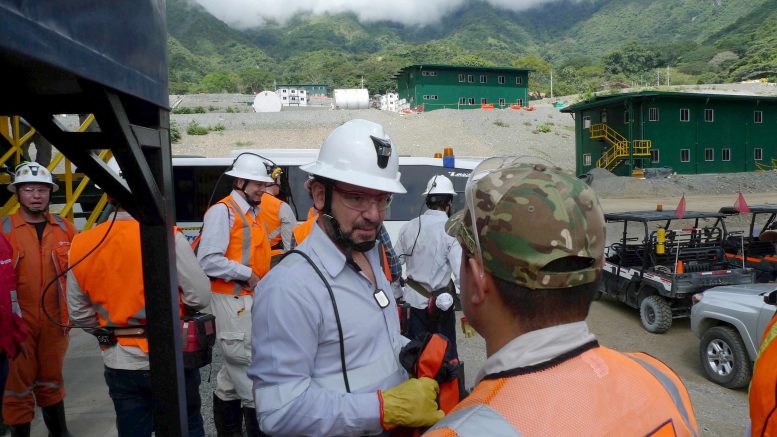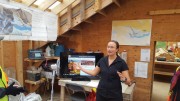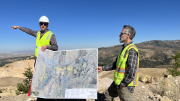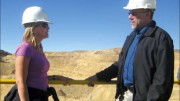BURITICA, COLOMBIA — It has been one year since The Northern Miner last toured the Buritica gold project, and the interim has been a critical period for Continental Gold (TSX: CNL).
“We’re fully permitted and on schedule for 2020 production,” says Donald Gray, Continental’s chief operating officer, on a spring site visit, 65 km northwest of Medellin in Colombia’s Antioquia department.
Next to a gold-rich mountain in the Andes, surface infrastructure is taking shape in the Higabra valley, including the primary crusher, grinding building, leach circuit, CCD circuit and Merrill–Crowe plant.
Buritica is scheduled to deliver 253,000 oz. gold per year on average over a 14-year mine life. The company estimates all-in sustaining costs of US$604 per oz. gold.
Initial mining will focus on the proven and probable reserves in the Yaragua and Veta Sur vein systems, which total 13.7 million tonnes grading 8.4 grams gold per tonne and 24.3 grams silver per tonne, for 3.7 million contained oz. gold and 10.7 million oz. silver. Continental plans to update its mine plan for the first three years of production before commercial production in 2020.
Broader resources for Yaragua and Veta Sur hold more than 11 million oz. gold in 16 million measured and indicated tonnes of 10.3 grams gold and 40.8 grams silver. An estimated 5.2 million oz. gold reside in 20.3 million inferred tonnes of 8.6 grams gold and 37.3 grams silver.

Processing facilities under construction in the Higabra valley at Continental Gold’s Buritica gold project, 65 km northwest of Medellin, Colombia. Photo by David Perri.
The US$512-million mine is 75% complete, according to an August update from the company, and construction has proceeded as planned, for the most part.
Gray says underground conditions have been more difficult than expected. Workers learned to slow down, identify bad ground and provide support before moving forward. Nonetheless, underground crews have been advancing ahead of schedule, averaging more than 1,000 development metres per month.
Drier-than-expected conditions were a pleasant surprise for Continental, which could mean less water through the treatment plant. “We permitted for more than twice the water we’re seeing today,” CEO Ari Sussman says.
In 2019, the company is completing 55,000 metres of definition drilling, focusing on stope preparation ahead of production. Another 18,500 metres of infill drilling will target recently identified broad mineralized zones (BMZs).
Buritica’s mineralization occurs in narrow, porphyry-related veins. The BMZs formed where the brittle interference between structures has resulted in wider mineralization footprints around the veins.
“The BMZs are simply the intersection of northwest structures with the main vein structures,” says special advisor David Reading. “They are the lower-grade halos — grading 3, or often 4 grams — surrounding high-grade veins.” As such, the BMZs could be mined more efficiently and deliver more gold.
Continental has released a resource estimate for BMZ1 in the Yaragua system totalling 828,870 measured and indicated tonnes grading 14.2 grams gold per tonne and 22.9 grams silver, for 400,000 contained oz. gold. BMZ1 runs 400 metres vertically and is open at depth. It ranges from 25 to 40 metres wide.
“We found five BMZs so far, and we haven’t really done that much work. I think there are a lot more,” Reading says.

Continental Gold special advisor David Reading and senior VP of external affairs and sustainability Ana Milena Vasquez prepare to go underground. Photo by David Perri
“The deposits are very much open at depth and on strike. It just requires more drilling. It’s not less prospective [in the undrilled areas], we just haven’t got around to it, because … our focus has been [on] drilling everything above the Higabra tunnel,” he says, referring to the tunnel that ascends from the valley into the Yaragua deposit.
On the financial front, Continental is on firm footing, after securing a US$175-million financing package in March 2019, which gives the company the funds to see Buritica through to production. The financing included US$100 million from Triple Flag Mining Finance for (2.1%) gold and (100%) silver streams. “We have the option to buy the gold stream back prior to Dec. 31, 2021 — and of course we’re going to do that,” CEO Sussman says.
Colombia ranked as the 48th most attractive mining jurisdiction according to the Fraser Institute’s latest Annual Survey of Mining Companies. Respondents to the survey highlighted security as a major concern.
While the illicit drug trade fuels much of the organized crime in Colombia, illegal mining is also a major problem, and has funded civil conflict and criminal activity in the country for decades.
After Continental’s 2008 discovery at Buritica, the population in the area nearly doubled to 13,000, as people came to the area to capitalize on the gold find. In 2016, Colombian authorities intervened to remove illegal miners from the property.
The company has supported the government’s push to formalize artisanals and promote best practices, and ensure the money from gold production doesn’t flow to criminal organizations.
Continental says Buritica hosts more formalized artisanals than any other Colombian project, with more than 300 individuals working on-site.
“Some work in what will be the crown pillar of the mine, others work in small areas away from our main infrastructure,” Sussman says.
The formalized miners have produced 2,700 oz. gold in the past three years, and will continue mining when Continental begins producing.
“It’s our gold. We’re actually carving off a small portion of our existing title, and asking the government to register it to them,” he says.
To qualify for formalization, miners must have roots in the area, and are subject to conditions set out by the company and government. The company provides training, technical assistance and even financing to the miners, who must sell their ore to Continental.
“Many of the local, small smelters are under serious investigation for processing ore belonging to illegal groups,” Sussman says. “So we make sure we process their ore, and then we sell it to a refinery located out of the country.”
National, regional and private security personnel patrol Buritica, aided by surveillance drones buzzing overhead. A few analysts on the tour said it was the first time they saw armed guards escort visitors underground.

A security officer on duty at the Buritica gold property. Photo by David Perri
“We’re not here to tell you that there is zero illegal mining,” Sussman says. The topography of Buritica makes it difficult to seal off to intruders. Plus, the punishment for illegal mining is not an effective deterrent, he says. “If you get caught, you get arrested, you go to jail — and the next day you’re free again.” The government is under pressure to punish illegal mining as severely as drug trafficking. “It’s moving in the right direction, but it’s not perfect yet.”
In 2016, the government reached a milestone peace agreement with FARC, formerly the biggest guerrilla group in the country, which agreed to put down its weapons. The deal marked the improving security situation in Colombia.
However, as hostilities cooled, dissident FARC members and other groups moved in to control the drug trade, according to analysis by InSight Crime, an academic foundation that reports on Latin American organized crime. In 2018, Colombia’s homicide rate rose for the first time in a decade, by 4% to 24 per 100,000. The homicide rate jumped 30% in former FARC-controlled municipalities.
Violence hit Continental in September 2018, when four employees were murdered in two separate incidents.
First, in the nearby town of Buritica, engineers were targeted as they headed to the project site for work — one was shot and killed. The engineers had been working on closing illegal mines at Buritica as part of their duties.
In June 2019, a member of the Gulf Clan was sentenced to 21 years in prison for the murder. The Gulf Clan is a significant criminal organization in Colombia, according to InSight Crime. Three others are charged in relation to the incident.
Later that month, a house where exploration geologists and contractors were living was attacked in the village of Ochali, within Continental’s Berlin gold property, an 8.5-hour (205 km) drive from Buritica town. Three geologists were shot and killed.
Authorities have identified seven suspects responsible for the killings: two have been sent to prison, three were killed in military operations and two have not been found. Local media reported the group included ex-FARC members and likely sought to discourage legal development, which would bring a larger state presence to the area.
After the incidents, Continental halted all work outside of Buritica and upgraded its security division, hiring leaders with extensive security and intelligence experience, Sussman says. Thousands of Continental employees and contractors continue to live in Buritica town, and other communities in the area.
At press time, Continental shares traded at $3.84 apiece, within a 52-week window between $1.76 and $4.66. The company has a $780-million market capitalization. Newmont Goldcorp (TSX: NGT; NYSE: GOLD) owns 19.9% of the company.






Be the first to comment on "Site visit: Continental stays on track at Buritica"